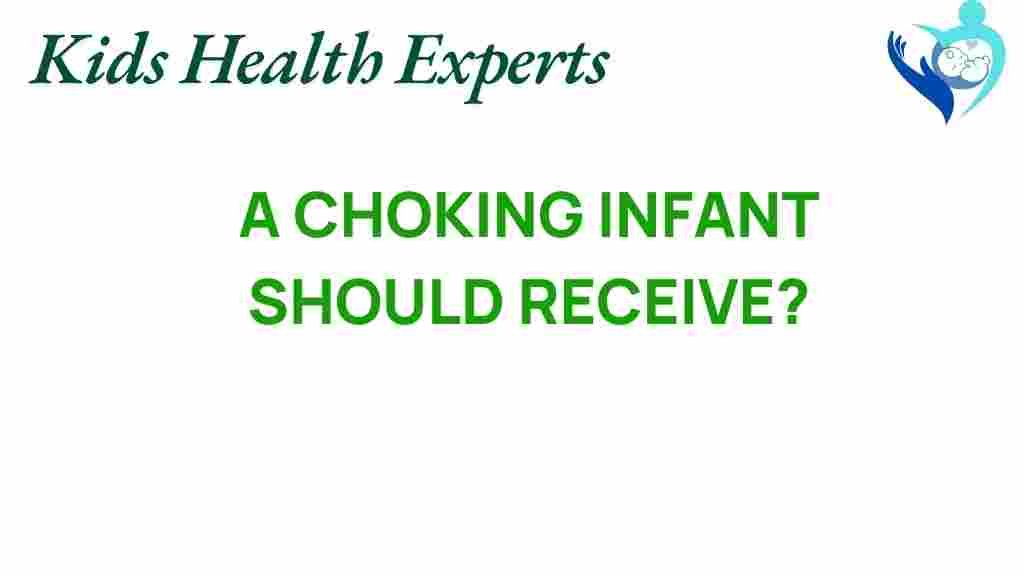What to Do When an Infant is Choking: Life-Saving Techniques
Choking is a frightening experience for any parent or caregiver, especially when it involves an infant. Understanding how to respond effectively can mean the difference between life and death. In this article, we will explore essential techniques for handling choking in infants, emphasizing the importance of infant safety, emergency response, first aid, and pediatric advice. By arming yourself with knowledge, you can ensure the safety and well-being of your little one.
Understanding Choking in Infants
Choking occurs when an object blocks the airway, preventing air from reaching the lungs. Infants are particularly vulnerable due to their natural curiosity and tendency to put objects in their mouths. Common choking hazards include:
- Small toys
- Food items (like grapes, nuts, and popcorn)
- Household items (like coins and batteries)
Recognizing the signs of choking is crucial. If your infant is choking, they may exhibit the following symptoms:
- Inability to cry or make sounds
- Difficulty breathing
- Coughing or gagging
- Blue or pale skin coloration
- Loss of consciousness
Emergency Response: Step-by-Step Techniques
When you identify that your infant is choking, it is essential to act quickly. Follow these steps for a safe and effective response:
1. Assess the Situation
First, determine if your infant is truly choking or just coughing. If they can cough, encourage them to continue, as coughing can help dislodge the object. However, if the infant cannot breathe, cry, or cough effectively, proceed to the next steps.
2. Call for Help
If you are alone, call emergency services immediately. If there are others present, ask someone to call while you attend to the infant. Quick intervention is crucial in choking emergencies.
3. Position the Infant
For infants under one year old, you should:
- Hold the infant face down on your forearm, supporting their head and neck with your hand.
- Ensure the infant’s head is lower than their chest.
4. Deliver Back Blows
Using the heel of your hand, deliver up to five firm back blows between the infant’s shoulder blades.
5. Perform Chest Thrusts
If back blows do not dislodge the obstruction, turn the infant face up, keeping their head lower than their chest. Using two fingers, perform up to five chest thrusts just below the nipple line.
6. Repeat If Necessary
Continue alternating between back blows and chest thrusts until the object is expelled or emergency help arrives. If the infant becomes unresponsive at any point, initiate CPR immediately and continue until help arrives.
Important First Aid Guidelines
Here are some critical first aid guidelines to remember when dealing with infant choking:
- Never reach into the infant’s mouth to remove an object unless you can see it clearly.
- Do not give the infant food or drink until you are certain they can swallow safely.
- Keep calm to ensure you can think clearly and respond effectively.
Common Troubleshooting Tips
Even with the best preparation, situations can vary. Here are some troubleshooting tips to keep in mind:
- **If the infant is still breathing but shows signs of distress:** Monitor closely and encourage coughing.
- **If the infant loses consciousness:** Begin CPR immediately and ensure emergency services are on the way.
- **If the object is visible:** Only attempt to remove it if you can do so safely without pushing it further down.
Parenting Tips for Choking Prevention
Prevention is always better than cure. Here are some solid parenting tips to reduce the risk of choking in infants:
- **Supervise eating:** Always supervise your infant during meals and avoid distractions.
- **Cut food appropriately:** Ensure food is cut into small, manageable pieces. Foods like grapes and hot dogs should be sliced into quarters.
- **Keep small objects out of reach:** Regularly check your home for small items that could pose a choking hazard.
- **Educate caregivers:** Ensure that everyone who cares for your infant is aware of choking hazards and knows how to respond.
Health Guidelines and Pediatric Advice
Consulting with your pediatrician about choking hazards and response strategies is advisable. They can provide tailored advice based on your infant’s age, development, and health. Regular check-ups can also ensure that you are informed about safety practices as your child grows.
Additionally, consider taking a certified first aid course that includes infant choking response. Many organizations offer training sessions that can empower you with the skills needed to handle emergencies effectively.
Conclusion
Choking is a serious concern for parents and caregivers, but knowing what to do can significantly improve the outcome. By understanding choking signs, following emergency response techniques, and implementing safety measures, you can protect your infant and ensure their well-being. Always prioritize infant safety, stay informed about health guidelines, and don’t hesitate to seek pediatric advice when needed. For more information on infant care and safety, visit this resource for comprehensive guidelines.
Finally, remember that preparation is key. Equip yourself with knowledge and skills, and your confidence in handling emergencies will grow. Stay vigilant, and your infant will thrive in a safe environment.
This article is in the category Care and created by KidsHealthExperts Team
